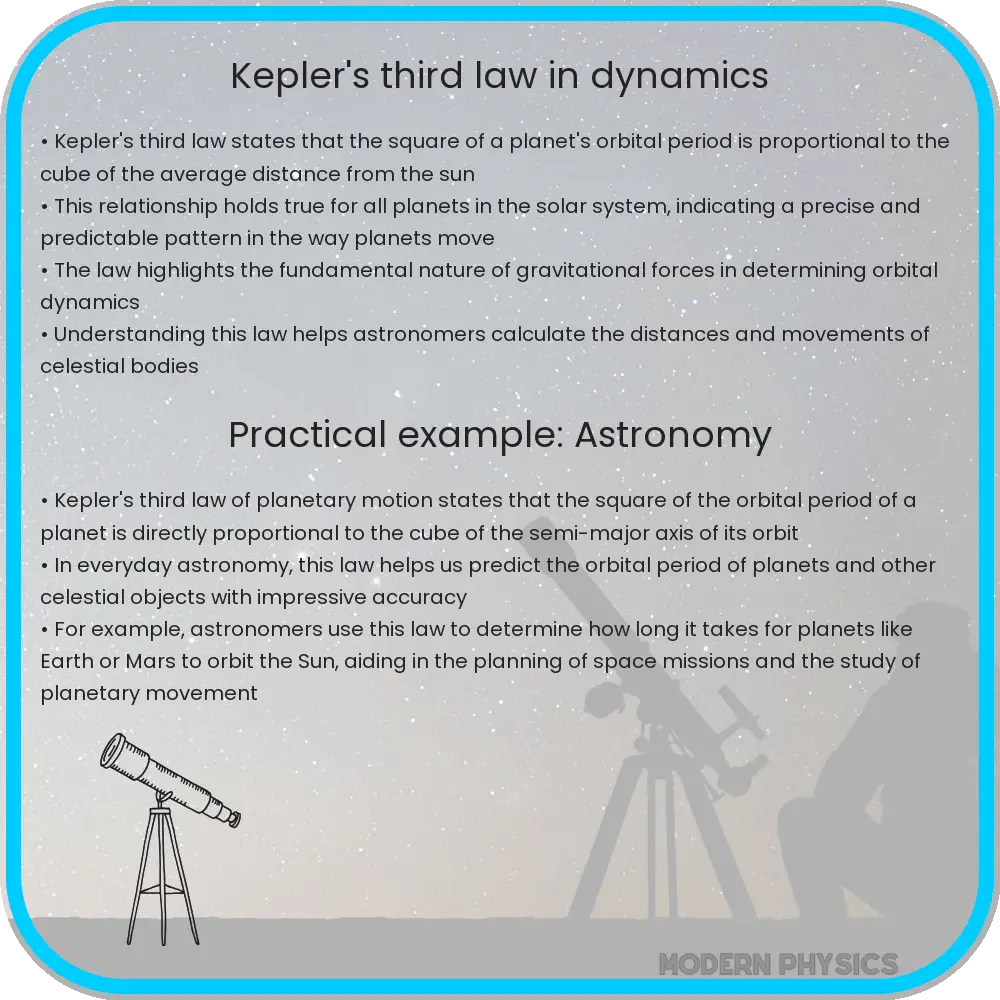Explore Kepler’s Third Law of Planetary Motion: its impact on astronomy, applications in modern space exploration, and significance in astrophysics.

Understanding Kepler’s Third Law of Planetary Motion
Johannes Kepler, a key figure in the scientific revolution of the 17th century, made significant contributions to our understanding of celestial mechanics. Among his most notable achievements is the formulation of Kepler’s Third Law of Planetary Motion. This law provides a fundamental relationship between the orbital period of a planet and its distance from the Sun, playing a crucial role in the field of astronomy and physics.
Kepler’s Third Law: The Harmonic Law
Kepler’s Third Law, often referred to as the Harmonic Law, states that the square of the orbital period of a planet (T) is directly proportional to the cube of the semi-major axis of its orbit (a). Mathematically, this is expressed as \( T^2 \propto a^3 \). When adjusted for units, the law becomes \( T^2 = \frac{4\pi^2}{G(M+m)}a^3 \), where \( G \) is the gravitational constant, \( M \) is the mass of the Sun, and \( m \) is the mass of the planet, although \( m \) is often negligible compared to \( M \).
Implications of Kepler’s Third Law
The law has profound implications in understanding the dynamics of celestial bodies. It implies that planets closer to the Sun, like Mercury and Venus, have shorter orbital periods compared to those farther away, such as Jupiter and Saturn. This relationship is instrumental in determining the distances of planets from the Sun and has been a cornerstone in celestial mechanics and astrophysics.
Application in Modern Astronomy
In contemporary astronomy, Kepler’s Third Law is used beyond our solar system. It assists in calculating the orbits of exoplanets around other stars. By observing the period of a star’s wobble caused by the gravitational pull of an orbiting planet, astronomers can apply Kepler’s Third Law to estimate the distance of the exoplanet from its star and infer its potential habitability.
Additionally, this law has been fundamental in missions like the Kepler Space Telescope, which has discovered thousands of exoplanets. Understanding the relationship between a planet’s orbital period and its distance from its star is crucial in identifying Earth-like planets in the habitable zone, where conditions might support life.
Kepler’s Third Law also finds applications in satellite dynamics. It’s used in calculating the orbits of artificial satellites and in planning space missions, making it a pivotal principle in the field of space exploration and satellite communication.
Overall, Kepler’s Third Law is not just a historical footnote but a living part of modern astronomy and space science. Its simplicity and far-reaching implications continue to guide our exploration and understanding of the universe.
Enhancing Our Understanding of the Universe
Kepler’s Third Law extends its influence beyond the confines of our solar system. In the realm of astrophysics, this law is instrumental in understanding the dynamics of binary star systems and the movement of stars within galaxies. By observing the orbital periods and estimating the distances of stars in a binary system, astronomers can calculate the mass of these stars, shedding light on stellar evolution and lifecycle.
Kepler’s Law in the Context of Gravitational Forces
The elegance of Kepler’s Third Law lies in its ability to relate the motion of celestial bodies to the fundamental force of gravity. Isaac Newton later expanded on Kepler’s work, formulating the Universal Law of Gravitation. This advancement allowed for a deeper comprehension of how gravitational forces not only govern planetary motion but also the interaction between any two masses in the universe.
Education and Kepler’s Third Law
In educational contexts, Kepler’s Third Law serves as a gateway for students to explore the concepts of orbital mechanics and gravitational forces. Its mathematical simplicity makes it an excellent tool for introducing students to the laws governing celestial motion, fostering a deeper appreciation for the intricacies of our universe.
Challenges and Future Perspectives
Despite its widespread application, Kepler’s Third Law faces challenges, especially in extreme astrophysical scenarios like those involving black holes or dark matter. These unique conditions require modifications and extensions of Kepler’s original formulations. As our understanding of the universe evolves, so too will our interpretations and applications of Kepler’s Law.
Conclusion
Kepler’s Third Law of Planetary Motion stands as a testament to the enduring power of observation and mathematical analysis in understanding the cosmos. From its initial use in deciphering the motion of planets in our solar system to its current applications in exoplanet discovery and satellite technology, this law continues to be a cornerstone in the field of astronomy. As we push the boundaries of space exploration and astrophysical research, Kepler’s insights remain as relevant as ever, reminding us of the elegance and simplicity inherent in the natural laws that govern our universe. Kepler’s Third Law, thus, is not just a historical concept but a living, evolving principle that continues to enlighten our journey through the cosmos.
